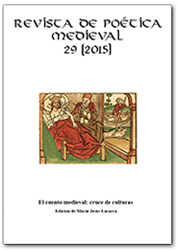The literary memory. Allegorical and cognitive mechanisms in medieval story-telling (from the exemplum to Conde Lucanor)
DOI:
https://doi.org/10.37536/RPM.2015.29.0.53287Keywords:
Literary memory, Conde Lucanor, Exemplum, Cognitive mechanisms, Allegory creating processAbstract
Memory is used as an allegory creating process as well as a cognitive mechanism in the exemplum, thus revealing the resources of the ars praedicandi and its implementation as a method of learning. Such resources, greatly used by these stories directly connected to the homily genre, reached a widespread use in story collections bearing an apparent didactic function where cognitive mechanisms achieve a special relevance while purporting a clearly exemplary intention. In this sense, the typical work is undoubtedly El Conde Lucanor, where the didactic intention, a faithful translation of the thought and credo of the author himself, determines the structure and the deep meaning of the text. The cognitive process assigned to memory stands out throughout the whole book, particularly in the ‘extradiegetic’ level where the author’s mind is re ected in his characters no less than in the very topics dealt with in the stories. The distance between the exemplum to the Libro de los ejemplos is determined by the cited artistic and moral concern, which enables the creation of a structure where Don Juan Manuel is identified himself with count Lucanor and the latter in turn with his characters, himself to be identi ed in the last instance by the readers who also assume the moral lessons implied in the stories.
Downloads
Métricas alternativas
Downloads
How to Cite
Issue
Section
License
The opinions and facts stated in each article are the exclusive responsability of the authors. The University of Alcalá is not responsible in any case for the credibility and aunthenticity of the studies.
Authors will retain the rights on their work, even if they will be granting the journal a non-exclusive right of use to reproduce, edit, distribute, publicly communicate and show their work. Therefore, authors are free to enter into additional, independent contracts for non-exclusive distribution of the works published in this journal (such as uploading them to an institutional repository or publishing them in a book), as long as the fact that the manuscripts were first published in this journal is acknowledged.
Works are published under the terms stipulated in the Attribution-NonCommercial-ShareAlike 4.0 International License (CC BY-NC-SA 4.0) that allows third parties to share the work under the following conditions:
Attribution — You must give appropriate credit, provide a link to the license, and indicate if changes were made. You may do so in any reasonable manner, but not in any way that suggests the licensor endorses you or your use.
NonCommercial — You may not use the material for commercial purposes.
ShareAlike — If you remix, transform, or build upon the material, you must distribute your contributions under the same license as the original.










